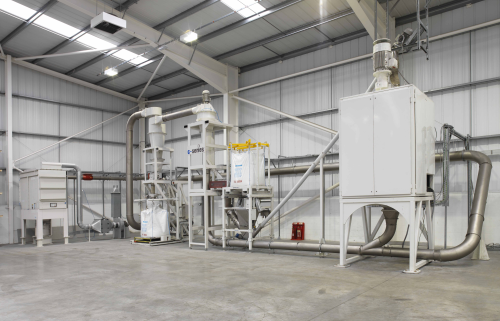
This grinding technology developed by IIT, Gateshead, UK, combines low energy consumption with a compact size and powerful grinding force. The energy efficiency of the new technology offers new opportunities for the fine grinding of GRP and other materials that were previously regarded as waste.
Recycling of GRP waste
IIT explains that glass reinforced plastic (GRP) is notoriously difficult to break down. For many years it has been regarded that the only viable option for disposing of waste GRP was landfill. In the UK alone it is estimated that around 150 000 tonnes of GRP are sent to landfill every year.
To help overcome this issue, IIT worked with a UK GRP manufacturer to explore methods of recycling GRP. As a result of this research and development work a GRP recycling plant has been installed and operational for almost 2 years. The company is involved in the manufacture of polycarbonate GRP products for the building sector and the recycled product is returned to the main batch as a fine powder for re-manufacturing.The quantity of GRP going to landfill has been eliminated and the company can now also claim recycled content in its products.
The process
This process involves GRP waste first being converted into flakes using shredding equipment. A secondary reduction is then carried out in an IIT m-series mill which converts the flakes into a fine powder of generally less than 100 microns.
Tests, and subsequent production runs, have shown that the inclusion of a percentage of this powdered material back into the primary batch for manufacture of new GRP products has no detrimental effect on the GRP in terms of strength‚ light transmission‚ light diffusion or durability.
New mill design
IIT explains that the majority of traditional grinding processes rely on air swept systems in which the feed materials are introduced into the grinding chamber in a stream of air. These air swept mills require significant power to maintain flow through the system. In addition‚ many conventional ball mill and similar grinding systems involve the fairly random application of the attrition force on the material in the mill.
The vertical mill developed and patented by IIT is a modular design capable of grinding soft‚ medium and hard materials to 9.5 on the Mohs scale and with 90% passing 45 microns and below.
Compact and powerful‚ the centrifugal grinding mechanism of the IIT m-series mill is extremely efficient‚ with the vertical material flow path and special roller assembly ensuring that the force produced is translated into maximum particle grinding power.
As a result‚ rather than relying on airflow to carry the feed materials through the mill and into contact with the grinding media‚ the IIT mill utilises natural centrifugal and gravitational forces to maximum effect.
In the m-series mill‚ the product in-feed mechanism and chamber comprises a rotating spreader plate which throws the material outwards (by centrifugal force) against the wall of the grinding chamber and downwards (by gravity) through the grinding module.
As the material descends‚ it is forced between the rollers and the outer grinding ring on the inside of the mill housing (barrel) and is reduced to a powdered form.
All material introduced into the mill must come into contact with the grinding module. The rotational speed of the rollers (typically 300 rpm) carrying the grinding heads controls the crushing force applied and the diameter of the mill housing determines the throughput volume.
Multi stage grinding is achieved through the incorporation of a number of grinding modules in series with particle size controlled both by the number of modules and rotational roller speed applied.
The materials for the grinding rollers – from tool steel through to tungsten carbide – can also be varied to meet the needs of different feedstocks.
Typically‚ a standard 600 mm mill barrel operating at 300 rpm produces a very fine powder output at up to 5 tonnes per hour and multi-mill configurations are available to meet capacities of up to 50 tonnes per hour.
As a result of the combination of a centrifugal grinding mechanism and the natural material flowpath‚ grinding efficiency is maximised with very low electrical energy input being required relative to the fineness and volume of powder produced.
For example‚ depending on the specific milling application‚ the energy consumption typically associated with the new m-series is 5-10 kWh/T. Traditional milling process typically utilise 3 to 10 times higher energy levels.





